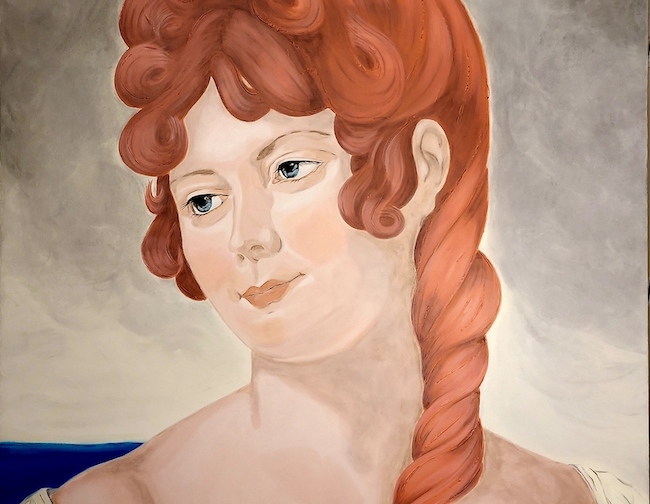Nel complesso mondo contemporaneo anche l’arte assume connotazioni che vanno verso quella tensione interiore ed espressiva che non può fare a meno di essere al contempo esplorazione del presente e interrogazione sul futuro che da quel vivere attuale può generarsi, con tutte le difficoltà, i timori e le ansie a cui l’uomo moderno, e di conseguenza anche l’artista, è sottoposto. Vi sono tuttavia alcuni creativi che preferiscono soffermarsi su un tempo che è stato, su un passato talmente remoto da permettere loro di entrare in una dimensione nostalgica eppure desiderosa di attingere a quel modo di vivere completamente diverso e apparentemente meno complicato di quello odierno. La protagonista di oggi contraddistingue la sua produzione artistica con un tocco pittorico classico per narrare un periodo distante nel tempo in cui la bellezza e la perfezione della forma erano considerati valori importanti della realtà quotidiana, forme di rispetto verso se stessi e gli altri da cui poi poter scendere verso profondità celate allo sguardo esterno.
Il corso del Ventesimo secolo è stato un susseguirsi di innovazioni, di aperture verso nuovi linguaggi artistici che hanno determinato in molti casi una forte e netta rottura con i concetti e le regole pittoriche e scultoree precedenti; nell’ambito di questa rivoluzione vi sono stati movimenti che hanno rinnegato ogni riferimento alla realtà osservata e all’attenzione verso la riproduzione estetica, a volte distaccandosi persino da ogni sentire interiore ed emotivo pur di affermare la supremazia del gesto plastico da ogni inquinamento oggettivo, altre invece mantenendo una più o meno evidente figurazione ma andando nel profondo dell’universo della mente, delle emozioni o delle paure più intime. Surrealismo, Metafisica, Espressionismo, avevano un radicato legame con la riproduzione della realtà che veniva però modificata dal sentire, come nel caso delle tele espressioniste, oppure diveniva un mezzo per permettere all’autore dell’opera e all’osservatore di riflettere sui significati nascosti della propria psiche, dei propri incubi, della solitudine e del suo rapporto con se stesso. Malgrado la tendenza ad andare verso l’innovazione più assoluta e distante dalle concezioni accademiche del passato, e quel ripiegamento verso una sfera soggettiva affrontata in differenti modi e stili espressivi, vi sono però stati movimenti che volevano mantenere il gusto estetico del passato, un approccio armonico, elegante, rappresentativo anche di quella parte di società che si legava al bel vivere, alla ripresa della normalità dopo le guerre che si sono succedute. Questo differente punto di osservazione fu il fulcro dell’Art Nouveau di Alfons Mucha, in cui venivano esaltate la bellezza e l’armonia delle forme sottolineando il contatto con la natura che diveniva cornice della levità dell’esistenza, e dell’Art Deco di Tamara de Lempicka, la quale però seppe dare una nuova freschezza e un carattere decisamente personale al tratto pittorico attraverso il quale metteva in evidenza donne al passo con i tempi ma legate alla tradizione dalle medesime pose languide e oziose delle dame raccontate dal maggior rappresentante dell’Impressionismo italiano, Giovanni Boldini.
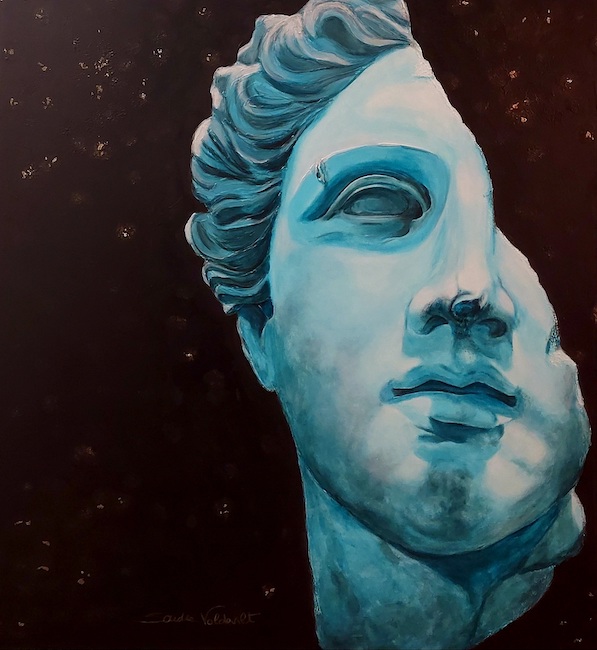
Dunque tanto nel Ventesimo secolo, quanto nel Ventunesimo, malgrado la tendenza generale a percorrere altre strade, vi sono stati e vi sono esempi di artisti che desiderano mantenere il contatto con quel gusto di altri tempi che contraddistingue il loro personale stile; l’artista torinese Sandra Valdevilt guarda con ammirazione al passato, come se volesse impedire che le sue linee guida vengano dimenticate ed è per questo che per la sua produzione sembra ispirarsi alla scuola ritrattista del Settecento, mostrando la medesima attitudine a mettere in risalto la donna che aveva caratterizzato le grandi artiste dell’epoca, Louise Elisabeth Vigée, Anne Seymour Damer, Rosalba Carriera, e mantenendo il tocco lieve e poetico così come la narrazione legata a quell’epoca troppo lontana e quasi troppo perfetta per essere attualizzata, preferendo pertanto raccontarla come era ma decontestualizzando quasi quei volti perfetti nel trucco e nelle elaborate acconciature, come se gli sfondi neutri avessero un tocco metafisico.
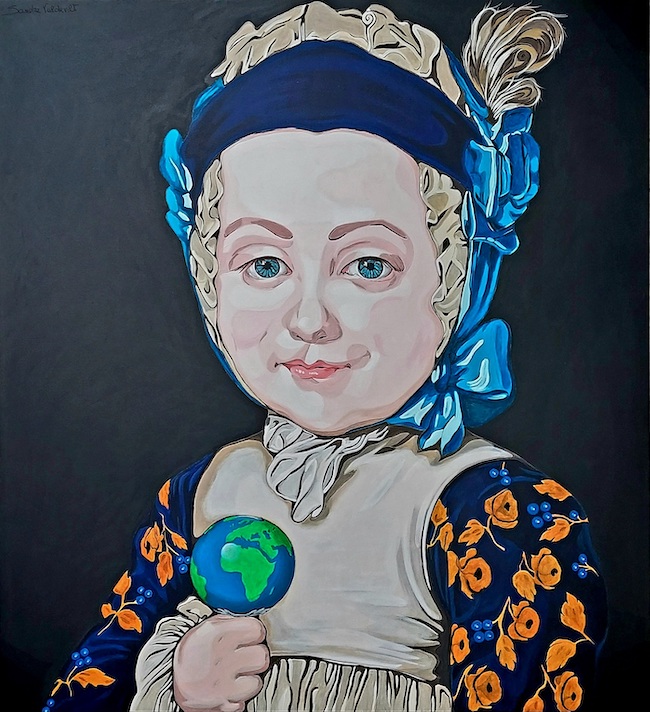
La capacità interpretativa della Valdevilt presenta una sensibilità estetica molto affine a quella del gusto settecentesco, le sue donne rappresentano l’alta società, la serenità della consapevolezza del ruolo importante che ricoprivano nella società dell’epoca seppure in apparenza marginale, non in primo piano. La serie dei ritratti è dedicata alla Venezia del passato, quella fiorente cittadina di mercanti, di navigatori, spesso all’avanguardia proprio in virtù dell’apertura verso l’esterno che era propria dei viaggiatori, mentre le loro donne attendevano a casa il frutto del lavoro degli uomini preoccupandosi di mostrare all’esterno il rango sociale a cui appartenevano indossando abiti sfarzosi, acconciature tanto più elaborate quanto più elevate erano le possibilità economiche della famiglia. C’è un certo sguardo indulgente e al tempo stesso incantato da parte di Sandra Valdevilt nei confronti delle protagoniste delle sue tele, quasi volesse inconsciamente compararle con un’epoca contemporanea in cui tutto si è modificato, in meglio per molti aspetti ma per altri forse in peggio poiché il mondo che si sta costruendo oggi non è quello che avevano immaginato gli antenati, quelle dame che forse disapproverebbero la disgregazione dei valori solo apparentemente superficiali, come le buone maniere, le formalità e la cura dell’apparenza che in fondo sottintendevano un maggiore rispetto per l’altro.
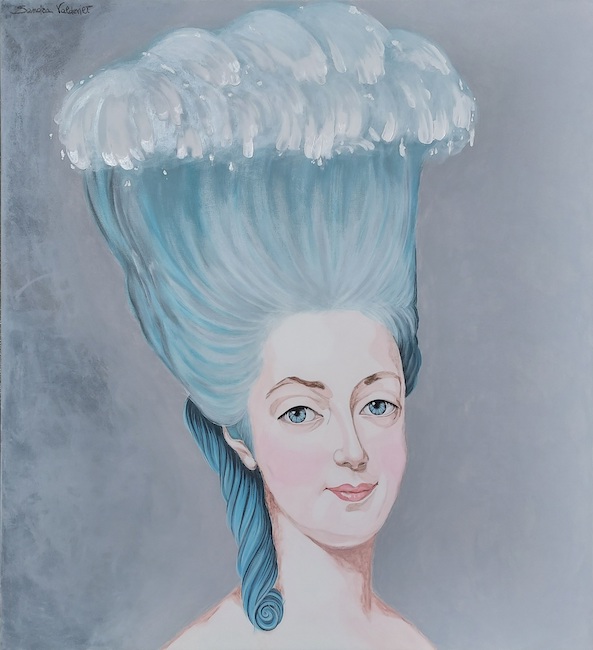
La tela La Serenissima racconta il fasto di una donna orgogliosa del suo stato sociale che però mostra nello sguardo e nei tratti del volto anche la sensibilità e la capacità di accogliere l’altro tipica delle donne veneziane, quell’essere nobildonne ma sempre in maniera delicata, magnanima con i lavoratori che prestavano servizio nelle loro case.
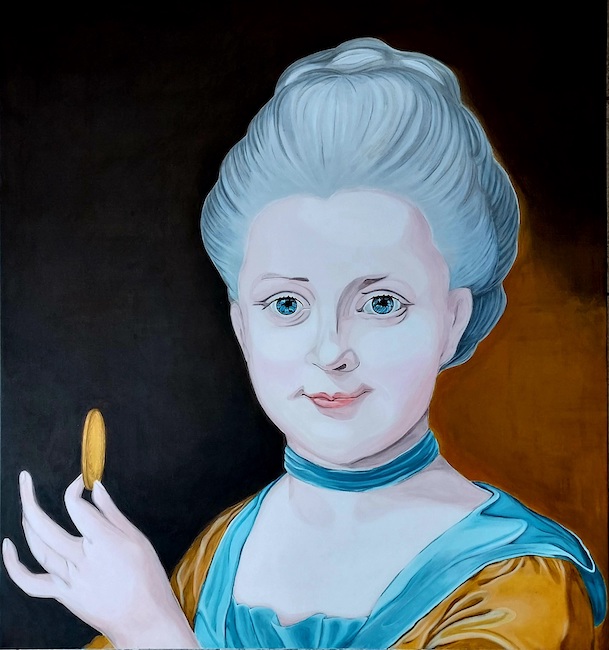
In Moneta è evidente l’approccio metafisico della struttura del quadro che adotta la Valdevilt, con lo sfondo che non è contestualizzato all’interno di una casa o di un’ambientazione esterna come avveniva per i ritratti della Carriera o della Vigée bensì è solo una base da cui l’immagine centrale può essere messa in evidenza con maggiore forza descrittiva, con tutta l’eleganza e la raffinatezza di una dama che compie il semplice gesto di mostrare una moneta, da un lato come se volesse mostrare la sua ricchezza ma dall’altro sembra quasi suggerire quanto sia importante dare rilevanza anche a qualcosa di piccolo per poter poi spingersi a desiderare di più. Non c’è arroganza nello sguardo della donna, piuttosto consapevolezza e invito a credere nel percorso che sta indicando.

Nella serie di opere dedicata agli animali Sandra Valdevilt manifesta in maniera più evidente il suo lato metafisico, sebbene si avvicini all’Espressionismo per le tonalità scelte che non appartengono al reale aspetto che si riscontra in natura bensì si legano a ciò che simbolicamente rappresentano; ecco dunque che il toro dell’opera Ombre rosse è rappresentato con il colore rosso, rosso come il sangue che da sempre macchia le arene, rosso come la passione dei matador che sfidano l’irruenza dell’indomabile animale, rosso come l’eccitazione del pubblico che sembra non riuscire a sottrarsi al fascino di quello spettacolo primordiale.
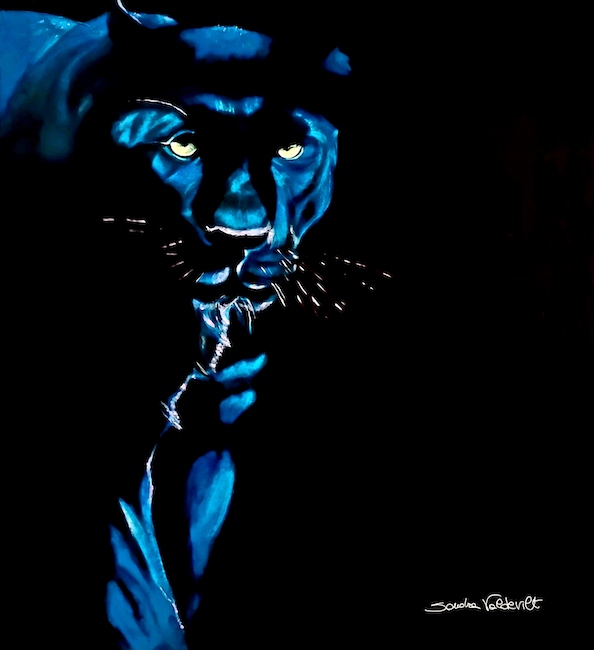
La tela Un faro nella notte evidenzia invece il mistero della pantera, un felino silenzioso e affascinante quanto pericoloso per la sua capacità di nascondersi nel buio; eppure la Valdevilt stravolge la convinzione comune giocando con il titolo, sovvertendone il senso del timore che può incutere e considerandolo da un altro punto di vista, quello secondo cui possa costituire una figura positiva, una protezione dalle reali insidie che nel buio si nascondono se ritiene che chi si pone di fronte a lei valga la sua fiducia, la sua dedizione.
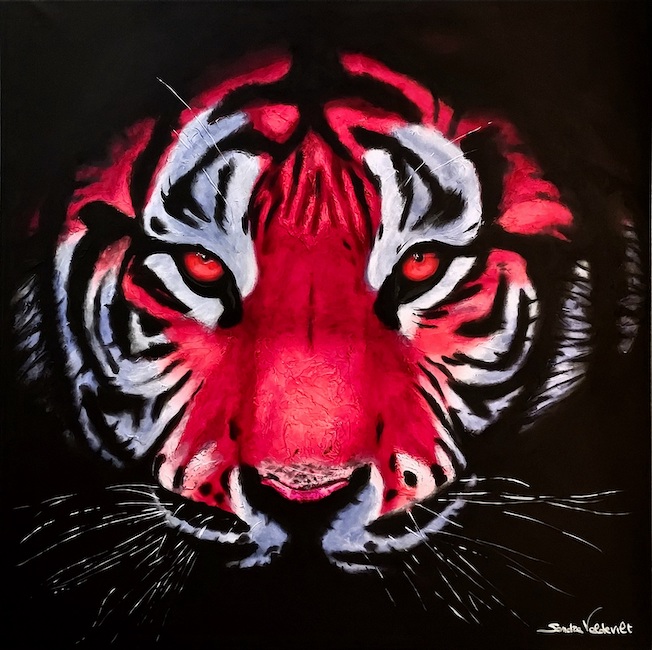
La decontestualizzazione, il mistero insito nelle cose animate e inanimate divengono dunque un tratto distintivo di Sandra Valdevilt che ammanta le sue tele di un silenzio mistico, di un’atmosfera avvolgente in grado di magnetizzare l’osservatore il quale viene spinto a soffermarsi sui dettagli, descrittivi ed emotivi, che l’artista desidera sottolineare. Sandra Valdevilt ha al suo attivo numerose e importanti mostre personali e collettive, ha preso parte a Expo Dubai 2021, le sue opere hanno ricevuto importanti premi ed è inserita nelle principali pubblicazioni italiane dedicate all’arte contemporanea.
SANDRA VALDEVILT-CONTATTI
Email: sandravaldevilt@yahoo.com
Sito web: https://www.sandravaldevilt.it/
Facebook: https://www.facebook.com/SandraValdevilt
Instagram: https://www.instagram.com/sandravaldevilt/
Refined taste, elegance and nostalgia for a bygone era in the artworks of Sandra Valdevilt
In the complex contemporary world, even art takes on connotations that go towards that inner and expressive tension that cannot help but be both an exploration of the present and a questioning of the future that can be generated by that current living, with all the difficulties, fears and anxieties to which modern man, and consequently also the artist, is subjected. There are, however, some creatives who prefer to dwell on a time that was, on a past so distant that it allows them to enter a nostalgic dimension, yet eager to draw on a way of life that is completely different and apparently less complicated than that of the present. Today’s protagonist characterises her artistic production with a classical pictorial touch to narrate a distant period in time when beauty and perfection of form were considered important values of everyday life, forms of respect towards oneself and others from which one could then descend to depths hidden from the outside gaze.
The course of the 20th century was a succession of innovations, of openings towards new artistic languages that in many cases led to a strong and clear break with previous pictorial and sculptural concepts and rules; within this revolution there have been movements that have repudiated all reference to observed reality and attention to aesthetic reproduction, sometimes even detaching themselves from all inner and emotional feelings in order to affirm the supremacy of the plastic gesture from all objective pollution, others instead maintaining a more or less evident figuration but going deep into the universe of the mind, of emotions or of the most intimate fears. Surrealism, Metaphysics, Expressionism, had a deep-rooted link with the reproduction of reality that was however modified by feeling, as in the case of Expressionist canvases, or became a means for the author of the artwork and the observer to reflect on the hidden meanings of his psyche, his nightmares, his solitude and his relationship with himself. Despite the tendency to move towards the most absolute innovation and away from the academic conceptions of the past, and that retreat towards a subjective sphere approached in different ways and styles of expression, there were, however, movements that wanted to maintain the aesthetic taste of the past, a harmonious, elegant approach, also representative of that part of society that was linked to the good life, to the resumption of normality after the successive wars. This different point of view was at the heart of Alfons Mucha’s Art Nouveau, in which the beauty and harmony of forms were exalted, emphasising the contact with nature that became a frame for the levity of existence, and of Tamara de Lempicka’s Art Deco, who, however, was able to give a new freshness and a decidedly personal character to the pictorial line through which she emphasised women in step with the times but bound to tradition by the same languid and idle poses as the ladies portrayed by the greatest representative of Italian Impressionism, Giovanni Boldini.
So in the 20th century, as well as in the 21st, despite the general tendency to go down other paths, there were and are examples of artists wishing to keep in touch with that taste of yesteryear that distinguishes their personal style; Turinese artist Sandra Valdevilt looks back to the past with admiration, as if she wanted to prevent its guidelines from being forgotten, and it is for this reason that for her production she seems to be inspired by the 18th century school of portraiture, displaying the same attitude of highlighting women that characterised the great female artists of the time, Louise Elisabeth Vigée, Anne Seymour Damer, Rosalba Carriera, and maintaining the light and poetic touch as well as the narrative link to that era that was too distant and almost too perfect to be actualised, preferring therefore to tell it as it was but almost decontextualising those perfect faces in the make-up and elaborate hairstyles, as if the neutral backgrounds had a metaphysical touch. Valdevilt’s interpretative ability shows an aesthetic sensitivity very close to that of 18th century taste, her women represent high society, the serenity of the awareness of the important role they played in the society of the time, albeit seemingly marginal, not in the foreground. The series of portraits is dedicated to the Venice of the past, that flourishing city of merchants, of navigators, often in the vanguard precisely because of the openness to the outside world that was characteristic of travellers, while their women waited at home for the fruits of the men’s labour, taking care to show off the social rank to which they belonged by wearing sumptuous dresses, the more elaborate hairstyles the higher the family’s economic possibilities were.
There is a certain indulgent and at the same time enchanted look on Sandra Valdevilt’s part towards the protagonists of her paintings, as if she unconsciously wanted to compare them with a contemporary era in which everything has changed, for the better in many respects but for others perhaps for the worse, since the world being built today is not the one the ancestors had imagined, those ladies who perhaps disapproved of the disintegration of values that were only apparently superficial, such as good manners, formality and care for appearances that basically implied greater respect for others. The canvas La Serenissima recounts the splendour of a woman proud of her social status who, however, also shows in her gaze and facial features the sensitivity and ability to welcome others typical of Venetian women, that being noblewomen but always in a delicate, magnanimous manner with the workers who served in their homes. In Moneta (Coin), the metaphysical approach to the structure of the painting that Valdevilt adopts is evident, with the background not contextualised within a house or external setting as was the case with the portraits of Carriera or Vigée, but is merely a base from which the central image can be highlighted with greater descriptive force, with all the elegance and refinement of a lady making the simple gesture of displaying a coin, on the one hand as if she wanted to show off her wealth but on the other hand almost seems to suggest how important it is to give importance to even something small in order to be able to go on to desire more. There is no arrogance in the woman’s gaze, rather awareness and an invitation to believe in the path she is indicating. In the series of paintings dedicated to animals, Sandra Valdevilt manifests her metaphysical side more clearly, although she comes close to Expressionism in the tones she chooses, which do not belong to the real appearance found in nature, but rather relate to what they symbolically represent; thus, the bull in the artwork Red Shadows is represented with the colour red, red like the blood that has always stained the arenas, red like the passion of the matadors who challenge the impetuosity of the indomitable animal, red like the excitement of the public who seem unable to escape the fascination of that primordial spectacle.
The canvas Un faro nella notte (A Lighthouse in the Night), on the other hand, highlights the mystery of the panther, a feline as silent and fascinating as it is dangerous due to its ability to hide in the dark; yet Valdevilt overturns the common belief by playing with the title, subverting its sense of the fear it can instil and considering it from another point of view, that according to which it can constitute a positive figure, a protection from the real pitfalls that lurk in the dark if it believes that those who stand before it are worth its trust, its dedication. Decontextualisation, the mystery inherent in animate and inanimate things thus become a distinctive trait of Sandra Valdevilt who cloaks her canvases in a mystical silence, in an enveloping atmosphere capable of magnetising the observer who is prompted to dwell on the descriptive and emotional details that the artist wishes to emphasise. Sandra Valdevilt has numerous important solo and group exhibitions to her credit, she took part in Expo Dubai 2021, her works have received important awards and she is included in the main Italian publications dedicated to contemporary art.


